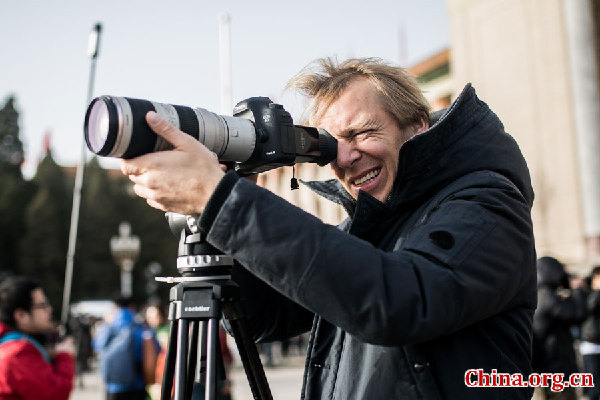For lawmakers and journalists alike, drop the toys
- By Ni Tao
 0 Comment(s)
0 Comment(s) Print
Print E-mail Shanghai Daily, March 14, 2016
E-mail Shanghai Daily, March 14, 2016
|
|
|
A journalist from an overseas media outlet is busy in Beijing's Tian'anmen Square, covering the annual session of the National People's Congress (NPC) on March 5, 2016. [Photo by Zheng Liang/China.org.cn] |
"What a view!" My father exclaimed as he watched Chinese Premier Li Keqiang deliver his televised annual government work report recently to the National People's Congress (NPC), China's top legislature. What he was referring to was the multiple rows of cameras at the back of the conference hall.
These cameras, and the people operating them, are a fixture of the yearly sessions of the NPC and the Chinese People's Political Consultative Conference (CPPCC), the country's top political advisory body. Together, the meetings of these two groups are referred to as the "two sessions," or liang hui in Chinese.
As a journalist, I'm no stranger to the high-end photo and video gear that one sees at these meetings. But over recent years, I've noticed that instead of carrying heavy, bulky cameras on their shoulders, some journalists have taken to using smartphones attached to scalable monopods, popularly known as "selfie sticks."
In fact, as the premier held forth, a handful of journalists made themselves distinguishable by holding such sticks, which are designed to position a smartphone or camera beyond the reach of one's arm.
This year, however, journalists are perhaps the only people using these fishing-rod-like instruments, because NPC deputies and CPPCC members are forbidden from using them.
According to Zhang Jing'an, a senior CPPCC official in charge of media affairs, it isn't appropriate for lawmakers and political advisors to be seen holding these sticks when they are supposedly at work. The ban, though not a sweeping one, is a reaction to the proliferation of fancy monopods seen at last year's meetings of the NPC and CPPCC.






